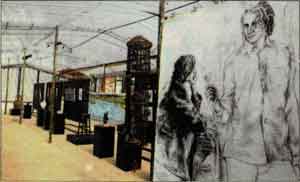
29 Oct Nothing arid about this art
FRANSI PHILLIPS
You might have wondered, driving in an easterly direction along Lynnwood Road, about the new building there, which is vaguely reminiscent of a farm stable and decorated with modern sculptures and pottery.
This very appropriate space, combining an industrial feel with the starkness and nostalgia of a stable in the Karoo, has been turned into an art gallery, and the idea came from experienced gallery owner Kerneels Laubscher and Catherine Gaum.
They aim to exhibit a variety of styles with the focus on a creative edge rather than on commercial value.
They would like to exhibit well established artists like John Clarke and Guy du Toit, who, despite their established styles, never lose their fresh approach to their subject matter, together with new artists and unknown students with messages from the future.
This attitude is quite obvious in their first exhibition.
Several artists in this exhibition display contemporary and experimental interpretations of southern African land-, sea- and cityscapes.
Artists in this category include Clarke, with his mysterious desertscape called Poles Apart,Carla Crafford’s Reeds, Lake Sibayi, in which the
relationship between photo and drawing or graphic art is reversed, and Eric Duplan’s strikingly magical Moon sleep,combining an ancient landscape with a futuristic dreamer.
A strange nostalgia for what has been lost can be felt in works like Jaco Benade’s Momenta,with pieces of historical porcelain and relief sculptures lost in a vast landscape, Phyllis Green’s photo of a fountain angel, and Griet van der Meulen’s Hold Onto, depicting a hand holding onto a bird and a doll, as well as her Shrine to 17 disappearing species per day.
A feeling of the transience of life and the mystery of ordinary objects is experienced in Antoinette Uys’ Transitional Moments, Du Toit’s Hoenderhaan and Crafford’s Undercover.
A sense of playful wonder can be detected in works like Anette
Pretorius’ Fragmente, depicting fragments of a wooden horse with the technical excellence for which the artist is known.
Works with social references to a post-apartheid South Africa are Hide your dirt (Cecile Huystek), hiding pieces of Lifebuoy soap in small bags made out of springbok skin, and Louise Kritzinger’s very interesting African Women, depicting a young white woman surrounded by African masks. . .
But despite all the variety, one is strongly aware of an artistic style developing: a kind of compromise between artistic integrity technical reliability and a strong element of unpredictability
One sincerely hopes that the adjoining restaurant will make works like these available to a public that might not usually go out of their way to see it.
Pretoria News article




No Comments